Ventilation in the bathroom and toilet
To ensure normal air exchange in a house or apartment, two components are needed: fresh air inflow through living rooms and its outflow from technical ones. Ventilation in the bathroom and toilet is one of the components of the outflow. Therefore, it is necessary to do it right.
According to the principle of operation, ventilation can be natural or mechanical, they also say - forced. Natural movement of air occurs due to the movement of the wind, temperature differences and resulting pressure drops. When mechanical ventilation is used, the air movement is caused by the fans.
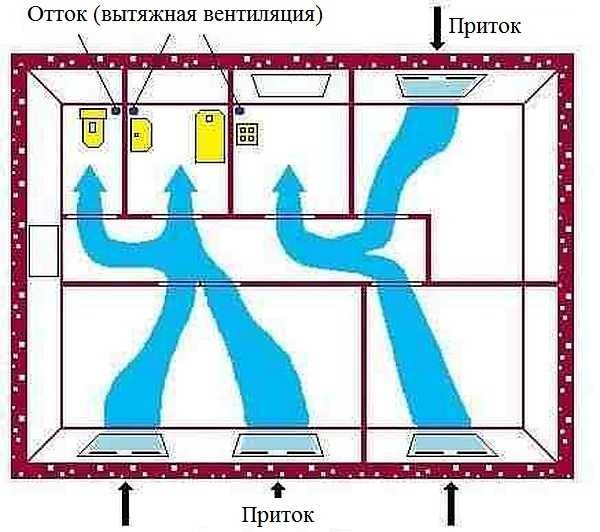
How to make a hood in the toilet: provide a normal flow of air in other rooms
From the point of view of an urban person, forced movement is preferable: everyone has long been accustomed to the fact that life support depends on the availability of electricity. And it rarely disappears in cities. But in rural areas in winter, power outages are more likely the norm. Therefore, they probably strive mainly to make the systems non-volatile, or at least redundant.
But natural ventilation in the toilet and bathroom should be too large. After all, the lower the speed of air movement along the channel, the larger the required air duct cross-section to ensure the transfer of the required volumes. No one would argue that the air moves faster when the fan is on. This is even reflected in SNiP: the rate of speed for ventilation systems with natural circulation is up to 1 m3/ h, for mechanical - from 3 to 5 m3/ h. Therefore, for the same room and conditions, the sizes of the channels will be different. For example, to transmit a stream of 300 m3/ h will need:
- with a forced channel with dimensions of 160 * 200 mm or a diameter of 200 mm;
- with natural circulation, a channel with dimensions of 250 * 400 mm or a pipe with a diameter of 350 mm.
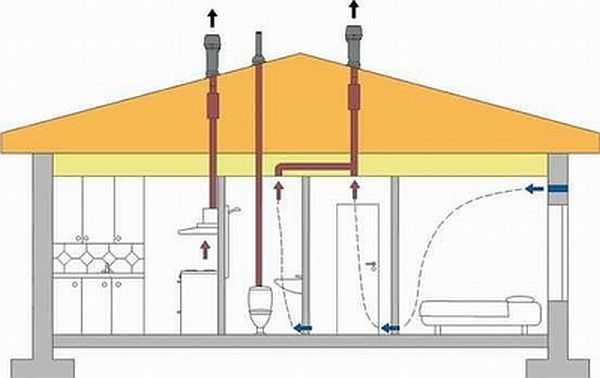
One of the schemes for organizing ventilation in the bathroom and toilet in a private house
Therefore, few people today make do with natural ventilation. Is that in small houses (up to 100 sq. M.). Even in apartments with roof channels, the ventilation of bathrooms and toilets is done using fans.
The content of the article
Organization rules
When arranging an air movement system, you need to remember the basic principle: in order for everything to work effectively, it is necessary to ensure the flow of air through the living rooms and its overflow into the technical ones. From there he already leaves through the ventilation ducts.
Today, air flow has become a problem: by reducing heating costs, we have cut off almost all sources of air supply. We put the windows sealed, the walls through which the air flowed at least a little, we insulate with airtight materials. The third source - the entrance doors - today, too, are almost all made of iron, with a rubber seal. Remained, in fact, the only way - airing. But we do not abuse it at all: it blows out the heat. As a result, the problem of dampness is added to the problems of lack of oxygen in the room: there is no inflow, and the outflow is ineffective. Even forced.
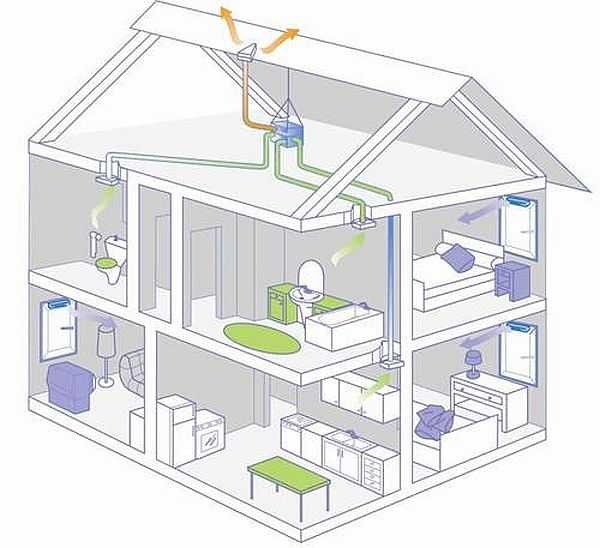
One of the options for organizing ventilation in a private house
If you want the ventilation to be normal, and the walls in the rooms are not "wet", make ventilation holes. There is such an option on metal-plastic windows, and there are separate devices that can be mounted anywhere on the wall. They are available with adjustable dampers, of various shapes and sizes, and are enclosed by gratings from the outside. It is best to install under windows, above or behind batteries.Then they are not visible in the room, and in winter the air coming from the street is heated.
Having provided the inflow, it is necessary to ensure that through the doors it enters the technical rooms. Therefore, under all the doors there should be cracks: through them the air will flow into other rooms. It is advisable to install a ventilation grill in the bathroom doors and / or also make a gap of at least 2 cm from the floor. The same rules apply to other technical areas: kitchen and toilet. Only when there is movement of air masses, ventilation will work.

The doors of technical rooms - kitchen, bathroom, toilet - must have ventilation grilles or valves. There is even a valve with noise absorption, and the smell, if properly organized, will never get into other rooms.
You may be interested in reading about how to build a wooden toilet in the country.
Calculation of fan performance for bathroom and toilet
To determine which fan to put on the bathroom with a toilet, you need to calculate the required air exchange. The calculation is a whole system, but when installing the fan, the main attention is paid to its characteristics: it provides the required air speed. In order not to get involved in the calculations, its performance can be taken by average numbers.

Air exchange rate for different rooms. They are used to calculate ventilation in the bathroom and toilet.
As you can see from the table (this is from SNiP) for a bathroom at least 25 m should be "pumped" in an hour3/ h, for a toilet or a combined bathroom, the speed should be twice as much - 50 m3/ h. These are the minimum values. In reality, however, through three (or two) technical rooms - a kitchen, a toilet, a bathroom - as much air should go as it enters through the supply ventilation.
The inflow is calculated by the volume of all living quarters and usually exceeds it by 1.5-2 times, and the minimum values indicated in the table are not enough to ensure the required air exchange. Therefore, the performance of the fans is taken at least with a double margin, and even more for kitchens: this way there will be no unpleasant odors in the apartment, as well as dampness and fungi. Therefore, going for a fan in a bathroom with a lower capacity than 100 m3/ h is better not to take.
How to assemble and install a shower stall is written here.
Choice
First of all, you need to decide where you will install the fan: in the channel or on the wall. Accordingly, the type: duct or wall. Wall-mounted versions can also be of two types: for installation at the inlet of the ventilation duct - they create more pressure, and for channelless installation - exit directly through the wall to the street. For channelless installation, axial fans are usually used - they cannot create a pressure of more than 50 Pa, for this reason they are not placed in the channels.
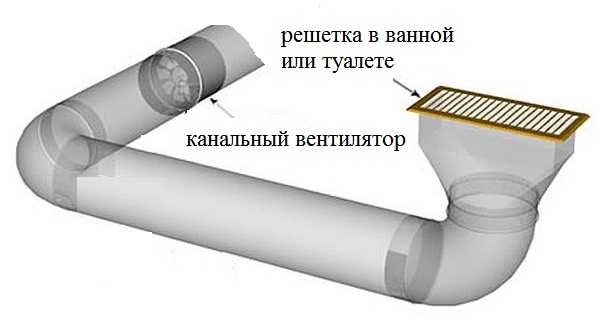
Duct fans are installed inside a duct or pipe. There it is, respectively, of a round or square section
In addition to the performance that you calculated, such a characteristic as the noise level is also important. The smaller it is, the better. It is good if the noise level is no more than 35 dB.
Another thing to pay attention to is the level of electrical safety. For use in rooms with high humidity, a protection level of at least IP 44 is required (indicated on the fan housing).
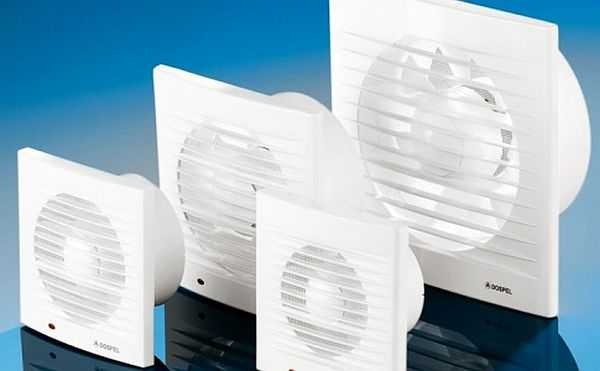
These are wall mount fans
Bathroom fan connection
The fan requires power supply and the main question is how to connect it. There are several possibilities:
- Connect in parallel with switching on the lighting. When you turn on the light in the bathroom or toilet, the fan automatically starts. But it also turns off automatically when the light is turned off. For a toilet this situation is normal, but for a bathroom it is far from always. For example, after taking a hot shower, all the steam will not go away.Therefore, for bathrooms, you can use a different method of connecting the fan or set a turn-off delay (a special device on which you can set the time interval after which the power is turned off).
- Bring it to a separate switch key or put a separate toggle switch / button.
- Set a timer that will automatically supply power on a schedule.
The electrical part is the hardest part. You will have to punch a strobe in the wall, “pack” the power cable into it, take it out to the place where the switch is installed and connect there, depending on the chosen method.
You can read how to make a shower stall with a tile tray in this article.
Checking the ventilation duct
Do-it-yourself installation of a fan in the bathroom begins after checking the condition of the channel. To do this, remove the grate, if it has not yet been dismantled, and bring a flame (candle, lighter) or a piece of paper to the opening. If the flame or leaf is pulled steadily towards the channel, the thrust is normal. If it stretches and bends back, the thrust is unstable. In this case, if you live in an apartment building, smells from neighbors above or below may get to you. Then the smell in the toilet from the ventilation is possible. It is necessary to stabilize the traction.
If the flame or leaf hardly deflects, the channel is clogged or blocked. In this case, mold and dampness, as well as an unpleasant odor, are guaranteed throughout the apartment, and in the bathroom, it is a must.
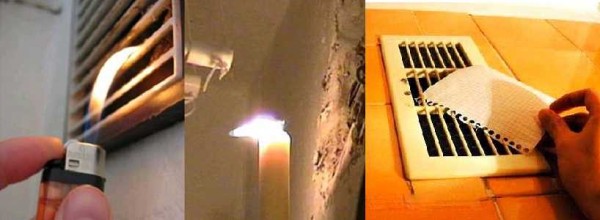
How efficient is ventilation in the bathroom and toilet is checked with a flame or a piece of paper
In the event of abnormal draft, residents of high-rise buildings clean the canals themselves or call maintenance services. In private houses, in any case, everything falls on the shoulders of the owners. If the channel is unstable, perhaps you brought it out without taking into account the wind rose and the thrust periodically overturns. You can fix the problem by moving the exit, but it's not easy. For a start, you can try to put a deflector (if not) or slightly increase / decrease the height.
Features of forced ventilation in the bathroom
When the fan is installed during its operation, the amount of exhaust air is significantly increased. But due to the fact that the body overlaps part of the channel cross-section, at other times, when the fan is not working, the flow decreases three times. As a result, the overall performance of the ventilation system drops.
To prevent this from happening, you can install a fan with a lower air intake grille and thus increase the capacity to normal. The second option is to leave a gap of 1.5-2 cm between the body and the wall during installation, i.e. make legs. Air will enter the gap and ventilation will be normal in any case. For more details, see the video.
Having chosen the installation method and the type of grille, you can proceed directly to the installation. Fan sizes vary. Therefore, each case is individual. But the basic steps are standard:
-
- A hole must be made on the tile for the case. The easiest way is to attach a fan and outline it. Then cut a hole of the appropriate size with a special drill bit or grinder.
- Remove the bezel from the fan. It is attached with one bolt at the bottom. The bolt was unscrewed, the grate was removed. Holes for fasteners are now visible. We insert in this form the fan into place (into the channel), mark on the tile with a pencil or marker the places where the bolts will be.
- With a drill of the appropriate diameter, we make holes in the tile and wall for the size of the dowel.
- We make an incision in the tile, where we will pass the power supply wire.
- Insert the dowels.
- We pull electrical wires through a special hole on the fan housing (if there is no hole, drill it).
- Install in place, tighten the bolts.
- We connect the wires.
- We check the performance and install the grill.
- Read about choosing a fan and calculating its performance here. For wooden toilets, all this is only partially true. Read about how to get rid of street toilet smells here.
Bathroom ventilation in a private house
Here, the main difficulties can arise when installing exhaust ducts. When planning, they can be brought together in one place and then taken out to the roof. This is more difficult from the point of view of internal wiring - you will have to pull the air ducts to the right place, and also more costly during construction. But the appearance is solid.
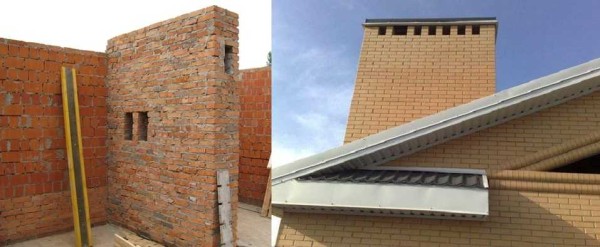
When planning a private house, you can collect all ventilation ducts in one place and bring them to the roof
Another way to arrange ventilation ducts is to bring it through the wall, and then lift it up along the outer wall. According to the rules, for normal traction with natural ventilation, they should rise 50 cm above the ridge. But one common duct will be displayed by you or a separate one for each room - it depends on your desire or on the layout. The picture will look something like this.
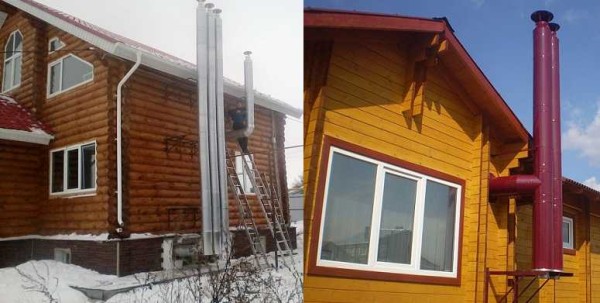
Exhaust ventilation in the bathroom and toilet of a private house can be organized in this way
There is another option: to make a mechanical hood that will work exclusively from a fan. Then, depending on the layout, one of the two options shown in the photo is suitable.
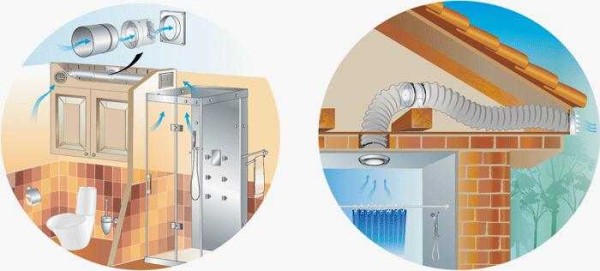
Options for mechanical ventilation of the bath in a private house
In the first case (on the left), the exhaust hole is made directly in the upper part of the wall (in order for air exchange to be effective, it must be located opposite the door, obliquely, at the top). This device uses a conventional wall fan. This figure also shows how you can reduce the number of required channels. If your bathroom and toilet rooms are close by, through a thin partition, then you can make a hole in the partition and install a grate. In this case, the ventilation of the bath will go through the toilet.
In the second version (in the photo on the right), an air duct with a duct fan is used. The solution is simple, only there is one caveat: if the air duct ends under the eaves of the roof (in the photo it is short, but there are also long ones), then the tree will turn black after a while. If you draw a conclusion from the toilet, this may not happen, and in the case of the bathroom, the high humidity will make itself felt after a couple of years. In this case, you can "pull" the duct to the cut of the roof or bring it up through the knee (but raise it by 50 cm above the roof).


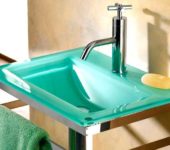
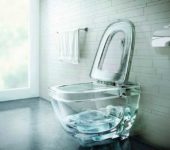

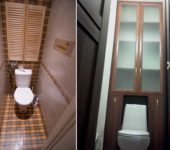





I bought an apartment on the secondary housing a couple of weeks ago and did not immediately see that there was no fan or ventilation grill in the combined bathroom! Immediately I thought, what kind of moron was doing repairs here? The previous owner, who took this apartment during the construction phase, was initially renovated for rent. Those. the most deshman repairs were made, but this does not explain the fact that there is no ventilation or it is there, but under the stretch ceiling.
I tried to figure out where the ventilation shaft is located. A metal box goes from the kitchen to the tub under the stretch ceiling, in some place it turns the box. Apparently you will have to remove the stretch ceiling and see what's what. In general, I did not expect such an ambush. How was the bathroom used for three years, taking into account the fact that the walls are plasterboard? For the sake of interest, I asked a person who had recently rented an apartment, how things were with the condensation on the walls during washing. He replied that there was condensation, but within a reasonable rate. His answer surprised me, because in another apartment and with the fan on, condensation is present.It turns out that under the stretch ceiling there is a hole in the shaft, and the steam passes around the three bulbs? Hard to believe. And so it turns out, I wanted to buy an apartment with renovation and move quickly. Now you have to rack your brains and invite repairmen, whom you still cannot find - everyone wants large objects, but you can't get enough of anyone for one room.